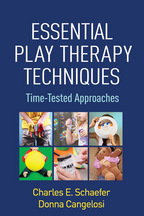Essential Play Therapy Techniques
Time-Tested Approaches
Charles E. Schaefer and Donna Cangelosi
A Paperback Originale-bookprint + e-book
A Paperback Original
orderJanuary 28, 2016
ISBN 9781462524495
Price: $44.00 280 Pages
Size: 7" x 10"
Sign up for emails on upcoming titles on Trauma & PTSD (with special discounts)!
“Schaefer and Cangelosi provide readers with a user-friendly guide of 58 different techniques with countless variations that can be applied while playing with children. The book is very well organized with interventions coming from seven broad categories that include techniques involving specific toys, metaphors, role-playing, creative arts, fantasy, and games….A variety of play therapists will appreciate that the authors interweave many popular theoretical orientations through the techniques, including cognitive behavior, Theraplay, psychoanalyses, humanism, solution focus, and more….Practitioners will benefit greatly from the authors’ personal expertise gained through decades of play therapy practice. They introduce each technique with a rationale that highlights specific benefits for the child….Schaefer and Cangelosi’s streamlined organization, clarity of writing, attention to a variety of client populations, and creativity offers a fresh new look and makes this a must-buy resource for play therapy students and practitioners alike.”

—American Journal of Play
“Each activity offers a basic description and variations of the play, age relevance, and what resources are required. What makes this book stand out is that each entry also includes a historical perspective of the play, rationale for its use, and empirical findings—all well referenced….Essential Play Therapy Techniqueshas prompted my creativity to step up a gear and has me and the counselors I supervise thinking of new ways to use common play activities. One of my favorite suggestions is to use bubble blowing as a way of modeling deep breathing and relaxation techniques….Counselors at any stage of development (but especially those just starting out) will likely gain new ideas or be pushed to think of their own, and perhaps have a bit of fun in learning their historical significance.”

—BACP Children and Young People
“What a wealth of information! Each chapter describes a type of play and its historical roots and empirical support. Uses of each type of play are detailed, providing an understanding of the therapeutic benefits. The relevant age range is clearly identified. Specific suggestions are given for selecting materials and tailoring techniques for different clients, which makes implementation easy. As a recommended text, the book will give students the knowledge needed to discriminate among different techniques. Thanks for this fresh look at the classics!”

—Linda E. Homeyer, PhD, LPCS, RPT-S, Professional Counseling Program, Texas State University
“A gem of a book. The authors have taken a transtheoretical approach to their selection of tried-and-true techniques for therapists of all theoretical orientations. The techniques are organized into clear categories and include helpful variations, making this a unique toolbox for clinicians who work with children.”

—Athena A. Drewes, PsyD, RPT-S, Director of Clinical Training, Astor Services for Children and Families, Middletown, New York
“Schaefer and Cangelosi offer a unique contribution to the field with this comprehensive exploration of play therapy techniques that have stood the test of time. Unlike many guides to play activities, the book includes a rationale for the use of each technique, empirical findings, and contraindications. It successfully combines applications and clinical foundations. This informative resource will prove useful for both novice and seasoned play therapists.”

—Sueann Kenney-Noziska, LCSW, RPT-S, private practice, Las Cruces, New Mexico
—American Journal of Play
“Each activity offers a basic description and variations of the play, age relevance, and what resources are required. What makes this book stand out is that each entry also includes a historical perspective of the play, rationale for its use, and empirical findings—all well referenced….Essential Play Therapy Techniqueshas prompted my creativity to step up a gear and has me and the counselors I supervise thinking of new ways to use common play activities. One of my favorite suggestions is to use bubble blowing as a way of modeling deep breathing and relaxation techniques….Counselors at any stage of development (but especially those just starting out) will likely gain new ideas or be pushed to think of their own, and perhaps have a bit of fun in learning their historical significance.”
—BACP Children and Young People
“What a wealth of information! Each chapter describes a type of play and its historical roots and empirical support. Uses of each type of play are detailed, providing an understanding of the therapeutic benefits. The relevant age range is clearly identified. Specific suggestions are given for selecting materials and tailoring techniques for different clients, which makes implementation easy. As a recommended text, the book will give students the knowledge needed to discriminate among different techniques. Thanks for this fresh look at the classics!”
—Linda E. Homeyer, PhD, LPCS, RPT-S, Professional Counseling Program, Texas State University
“A gem of a book. The authors have taken a transtheoretical approach to their selection of tried-and-true techniques for therapists of all theoretical orientations. The techniques are organized into clear categories and include helpful variations, making this a unique toolbox for clinicians who work with children.”
—Athena A. Drewes, PsyD, RPT-S, Director of Clinical Training, Astor Services for Children and Families, Middletown, New York
“Schaefer and Cangelosi offer a unique contribution to the field with this comprehensive exploration of play therapy techniques that have stood the test of time. Unlike many guides to play activities, the book includes a rationale for the use of each technique, empirical findings, and contraindications. It successfully combines applications and clinical foundations. This informative resource will prove useful for both novice and seasoned play therapists.”
—Sueann Kenney-Noziska, LCSW, RPT-S, private practice, Las Cruces, New Mexico



